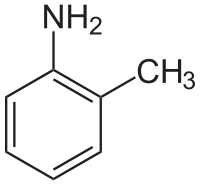O-toluidine
 |
|
| Names | |
|---|---|
|
Preferred IUPAC name
2-Methylaniline
|
|
| Other names
o-Methylaniline
o-Toluidine (no longer recommended) 1-Amino-2-methylbenzene 2-Aminotoluene |
|
| Identifiers | |
|
95-53-4 |
|
| ChEBI |
CHEBI:66892 |
| ChEMBL |
ChEMBL1381 |
| ChemSpider |
13854136 |
| ECHA InfoCard | 100.002.209 |
| KEGG |
C14403 |
| PubChem | 17395403 |
| UNII |
B635MZ0ZLU |
| Properties | |
| C7H9N | |
| Molar mass | 107.16 g·mol−1 |
| Appearance | Colorless to pale-yellow liquid |
| Odor | Aromatic, aniline-like odor |
| Density | 0.97759 g/cm3 |
| Melting point | −23.7 °C (−10.7 °F; 249.5 K) |
| Boiling point | 200 to 202 °C (392 to 396 °F; 473 to 475 K) |
| 0.19 g/100 ml at 20 °C | |
| Vapor pressure | 0.307531 mmHg (25 °C) |
| Hazards | |
|
EU classification (DSD)
|
|
| NFPA 704 | |
| Flash point | 85 °C (185 °F; 358 K) |
| 481.67 °C (899.01 °F; 754.82 K) | |
| Lethal dose or concentration (LD, LC): | |
|
LD50 (median dose)
|
900 mg/kg (rat, oral) 3235 mg/kg (rabbit, oral) |
| Related compounds | |
|
Related compounds
|
Toluidine |
|
Except where otherwise noted, data are given for materials in their standard state (at 25 °C [77 °F], 100 kPa).
|
|
| Infobox references | |
o-Toluidine (ortho-toluidine) is an organic compound with the chemical formula C7H9N. This arylamine is a colorless to pale-yellow liquid with a poor solubility in water.
Through biological monitoring it was discovered that o-toluidine may be absorbed through inhalation and dermal contact. Extensive absorption (at least 92% of the administered oral dose) of o-toluidine from the gastrointestinal tract was observed. Studies show that the absorption of o-toluidine from the gastrointestinal tract in rats is rapid with peak values at 1 hour; the blood values were near zero in 24 hours. It is expected of aromatic amines, like o-toluidine, to be absorbable through the skin due to their lipid solubility. 48 hours following subcutaneous injection of labeled o-toluidine hydrochloride into rats, detected radioactivity in decreasing range: liver > kidney > spleen, colon > lung, bladder. In another study, 72 hours after oral application to rats, radioactivity was detected in decreasing range: blood > spleen > kidney > liver > subcutaneous abdominal fat > lung > heart > abdominal skin > bladder > gastrointestinal tract > bone marrow > brain > muscle > testes. The main excretion pathway is through the urine where up to one-third of the administered compound was recovered unchanged. Major metabolites were determined to be 4-amino-m-cresol and to a lesser extent, N-acetyl-4-amino-m-cresol, azoxytoluene, o-nitrosotoluene, N-acetyl-o-toluidine, N-acetyl-o-aminobenzyl alcohol, anthranilic acid, N-acetyl-anthranilic acid, 2-amino-m-cresol, p-hydroxy-o-toluidine and other unidentified substances. Conjugates that were formed were predominated by sulfate conjugates over glucuronide conjugates by a ratio of 6:1.
...
Wikipedia

